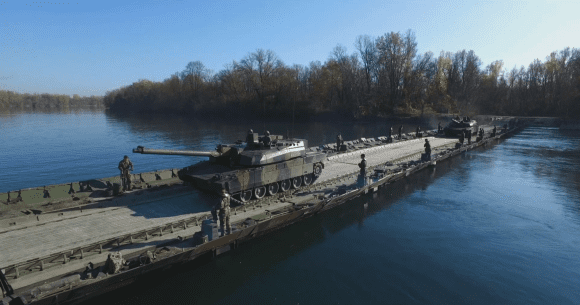New Floating Bridge Systems for the Polish Armed Forces, as of 2025 [INTERVIEW]

Photo. CNIM Systèmes Industriels
Defence24.pl speaks to Xavier Montazel, Director for Defence Matters at CNIM Systèmes Industriels on the pontoon bridge systems that will be fielded to the Polish Army.
Jakub Palowski: Poland has signed a framework agreement for CNIM Systèmes Industriels motorised floating bridges in mid 2022, and in August a first execution contract was concluded. What will be the next steps, toward the delivery of the system and potentially achieving the operational capability for the Polish Army?
Xavier Montazel: The framework agreement signed with the Polish Armed Forces refers to a typical PFM package, configured as a 100 meters long bridge, or as 2 50-meter-long ferries. The configuration includes all the necessary vehicles, trailers, and logistical assets. The delivery of the first two PFM sets for the Polish Armed Forces is planned to happen in mid-2025. Meanwhile, we also expect further packages to be procured, at regular intervals. Those would be delivered after 2026.
Could you please remind us what the PFM - Motorized Floating Bridge is?
Motorized Floating Bridge is one of a kind solution, designed for crossing water obstacles (rivers, lakes), by military vehicles. The individual modules, transported by tracked platforms, or by 8x8 trucks, allow for easy assembly of a pontoon bridge in less than 1 hour, making it possible to cross the obstacle for all types of fighting vehicles. To meet a variety of terrain conditions, the bridge comes in two primary configurations - as a fixed bridge, or as a ferry, with different setup options.
The PFM system has been operated for 3 decades now, in armed forces all over the world. More than 5,500 meters of this bridge are operated around the world, bringing complete satisfaction to the user group.

Photo. CNIM Systèmes Industriels
What are the capabilities and advantages of the Polish PFM system?
The latest variant of the PFM pontoon bridge that would be delivered to the Polish Armed Forces by 2025 is enhanced with the most modern of tactical and technological capabilities.
The latest version of the Motorized Floating Bridge, which is also highly mobile and easy to deploy, ensures safe and rapid crossing for all vehicles, up to the MLC90T/100W class. PFM does not require any extra boats for deployment, thanks to the integrated onboard motors it offers good agility and performance on the water. As the modules are 11 meters long, PFM requires fewer pontoons, trucks, and personnel than any other system of its kind. Apart from the tactical and technological advantages, this translates into a significant LCC optimization for the whole system. CNIM Systèmes Industriels also delivers proper training, to make it easy for the units using the PFM system to rapidly achieve readiness.
Read more
What vehicle types can be handled by PFM?
The PFM pontoon bridge system has been designed to allow all types of wheeled and tracked drivetrain vehicles to cross water obstacles. This pertains to all vehicles currently operated by the Polish Armed Forces, or vehicles planned to be introduced, heavy tracked vehicles included:
a. All classes of main battle tanks:
i. T-family: T72M1 (also the upgraded ones), PT91, foreign T-family MBT variants,
II. Leopard family: 2A4, 2A5, 2PL,
III. Abrams family: SEPv2, SEPv3, also with extra equipment and armour,
IV. K Family: K2, K2PL
b. Heavy tracked support vehicles, such as the M88A2 ARV, future Kajman ARVs, armoured engineering vehicles, and assault bridges;
c. Any other vehicles operated by all branches of the military;
What is the most demanding vehicle that could be accommodated by a pontoon water obstacle crossing system?
Main Battle Tanks are the most demanding vehicles for pontoon bridges, due to their heavy weight, and density of that weight. Among those MBTs, the heavy M1A2 Abrams SEPv3 is the most demanding vehicle. With extra equipment, the crews, and ammo, the M1A2 SEPv3 MBT may weigh more than 73 tonnes. The main battle tank in question can cross any water obstacles without any earlier preparation, using the PFM pontoon bridge set.
To what extent is the PFM interoperational with other systems used by NATO? How interoperability as such may be ensured?
It is relevant for a newly procured bridge set to work with other elements of the floating bridges inventory operated by the given Army, and also with floating bridges operated by the allies. The PFM tactical ramp is the means that ensures this natural interoperability. It is possible to connect any PFM bridge with any floating bridge in a simple, operational manner. This PFM's interoperability has been proven during numerous NATO exercises.

Could you please list the markets where the PFM is being used or offered?
PFM is being marketed on all identified markets where procurement and upgrade necessity has been recognized for NATO member states pontoon bridge systems.
CNIM Systèmes Industriels has been active in the defence domain since more than 150 years now. What is the role that the company plays in the French industry, also when it comes to strategic deterrence?
CNIM Systèmes Industriels has been supporting Armed Forces around the world, the French Armed Forces in particular, since 1856. We offer solid, proven, state-of-the-art equipment and solutions. Our products make it possible to render the land projection of power, and to support soldiers and convoys, thereby guaranteeing operational fluency.
We also offer high-class naval equipment for submarines and surface combatants in France, and abroad, meeting the needs of our clients.
CNIM Systèmes Industriels has been the main participant of the French deterrence programmes since 1961, acting as the sole supplier of missile launchers integrated on nuclear submarines.
And to conclude - a general question - how do you view the demand for PFM and similar systems, considering the current security context in Europe? What role bridges as such could play?
Before the conflict in Ukraine the NATO member states have been expressing increased demand for pontoon bridges, as most of the European pontoon bridges inventory has procurement dates 2 or 3 decades ago. They are no longer capable of accommodating the current, and future MBT designs. The conflict in Ukraine and the re-emergence of risk that fights may break out in Europe contribute to the existing demand for new pontoon bridge systems. Recent events have shown that a pontoon bridge set is a must to carry out manoeuvre warfare in Europe, where water obstacles can be encountered every 30 kilometres.
A separate, yet correlated matter relates to the future support for restoring the Ukrainian critical infrastructure. This includes the ability to establish new bridges quickly in a country that lost a significant percentage of its fixed bridge structures.
Thank you for this conversation.




